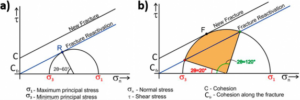3.4 Reactivation of Pre-Existing Structures
Planar features such as foliation (e.g., schistosity, gneissic banding, mylonitic orientation), sedimentary bedding, and lithological contacts can be reactivated as fractures during brittle deformation events. Likewise, fractures formed under an older tectonic event with a specific stress field may undergo displacement when subjected to a younger tectonic event. This phenomenon, called reactivation, happens when the orientation of the older fractures, with respect to the newer stress field, is favorable for opening or shear.
The Mohr diagram shows that reactivation requires smaller stresses than those needed for the generation of new fractures. This happens because the cohesion of the rock along any previous structure, such as foliation (Cf), is smaller than the one across the existing structure (C)(Figure 39). A smaller cohesion causes the failure envelope to move downward in the Mohr diagram, and the required stresses to reactivate the foliation will depend on the angle between this structure and σ1; for specific values of differential stress, a range of foliation orientations can be reactivated by shear (Figure 39b). Fracture orientations may mimic the foliation orientation, and this is especially apparent when the foliation is folded (Manda et al., 2008; Fernandes et al., 2016b, among many others). Depending on the magnitude of the principal stresses and on the orientation of the foliation, reactivation can occur by shear, opening, or both.

Figure 39 – Shear strength along the foliation (Cf) is smaller than that across foliation (C). Thus, fractures formed by reactivation along foliation (brown traces) require smaller stresses than fractures that cut across foliation. a) The foliation is approximately 30° (2θ = 60°) from σ1; this is the most favorable angle for reactivation because the required values of σ1 and σ3 are smallest at this angle. b) The angle between the foliation and σ1 ranges from 20° (2θ = 40° red point) up to 50° (2θ = 100° green point); in this latter case the stresses, σ1 and σ3, required to reactivate the foliation as a fracture are larger. c) The foliation is perpendicular to σ1; in this case, only across-foliation fractures will be formed. The scale of the axes is the same in each diagram for ease of reference to compare the Mohr circle sizes (based on Fossen, 2016).
The reactivation of pre-existing fractures occurs more easily than reactivation along foliation because there is no cohesion (C) along fracture surfaces (Figure 40). The most readily reactivated fractures are those that make an angle θ close to 30° with σ1 (Figure 40a). However, under larger differential stresses, a range of pre-existing fracture orientations will be reactivated by shear (Figure 40b). When the existing structures make a near-normal angle with a tensile σ3, the reactivation can occur by opening.

Figure 40 – Conditions required for reactivation of previous fracture surfaces. a) As the cohesion along an existing fracture (Cfr) approaches zero, reactivation of existing fractures requires smaller differential stress. b) When the differential stress is larger, a wide range of existing fractures making a variety of angles with σ1 (2θ ranges from 20° to 120° in the example) will be reactivated. In this example, the differential stress is also large enough to form new fractures (point F in the Mohr circle). The scale of the axes is the same in each diagram for ease of reference to compare the Mohr circle sizes (based on Fossen, 2016).
The reactivation of pre-existing structures is a common phenomenon, mainly in rock terrains that have undergone a long geological evolution. Even small shear displacements caused by reactivation may increase fracture transmissivity and influence the flow of groundwater. The implications of reactivation on flow are explained below in Section 3.5.
